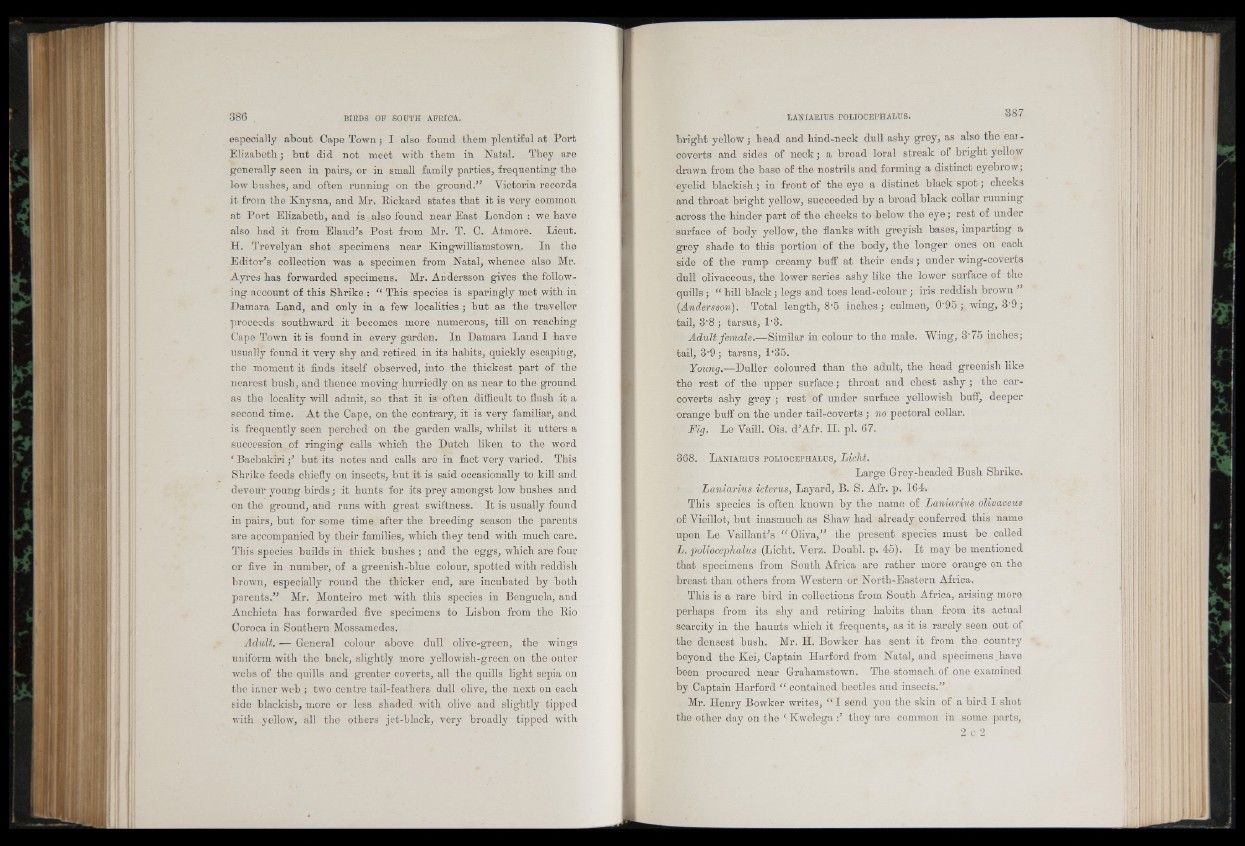
especially about Cape Town ; I also found them plentiful at Port
Elizabeth ; but did not meet with them in Natal. They are
generally seen in pairs, or in small family parties, frequenting the
low bushes, and often running on the ground.” Victorin records
it from the Knysna, and Mr. Rickard states that it is very common
at Port Elizabeth, and is also found near East London : we have
also had it from Eland's Post from Mr. T. C. Atmore. Lieut.
H. Trevelyan shot specimens near Kingwilliamstown. In the
Editor's collection was a specimen from Natal, whence also Mr.
Ayres has forwarded specimens. Mr. Andersson gives the following
account of this Shrike : “ This species is sparingly met with in
Damara Land, and only in a few localities; but as the traveller
proceeds southward it becomes more numerous, till on reaching
Cape Town it is found in every garden. In Damara Land I have
usually found it very shy and retired in its habits, quickly escaping,
the moment it finds itself observed, into the thickest part of the
nearest bush, and thence moving hurriedly on as near to the ground
as the locality will admit, so that it is often difficult to flush it a
second time. At the Cape, on the contrary, it is very familiar, and
is frequently seen perched on the garden walls, whilst it utters a
succession of ringing calls which the Dutch liken to the word
‘ Bacbakiri■/ but its notes and calls are in fact very varied. This
Shrike feeds chiefly on insects, but it is said occasionally to kill and
devour young birds; it hunts for its prey amongst low bushes and
on the ground, and runs with great swiftness. It is usually found
in pairs, but for some time after the breeding season the parents
are accompanied by their families, which they tend with much care.
This species builds in thick bushes; and the eggs, which are four
or five in number, of a greenish-blue colour, spotted with reddish
brown, especially round the thicker end, are incubated by both
parents.” Mr. Monteiro met with this species in Benguela, and
Anchieta has forwarded five specimens to Lisbon from the Rio
Coroca in Southern Mossamedes.
Adult,. — General colour above dull olive-green, the wings
uniform with the back, slightly more yellowish-green on the outer
webs of the quills and greater coverts, all the quills light sepia on
the inner web ; two centre tail-feathers dull olive, the next on each
side blackish, more or less shaded with olive and slightly tipped
with yellow, all the others jet-black, very broadly tipped with
bright yellow; head and hind-neck dull ashy grey, as also the ear -
coverts and sides of neck; a broad loral streak of bright yellow
drawn from the base of the nostrils and forming a distinct eyebrow;
eyelid blackish 5 in front of the eye a distinct black spot; cheeks
and throat bright yellow, succeeded by a broad black collar running
across the hinder part of the cheeks to below the eye; rest of under
surface of body yellow, the flanks with greyish bases, imparting a
grey shade to this portion of the body, the longer ones on each
side of the rump creamy buff at their ends; under wing-coverts
dull olivaceous, the lower series ashy like the lower surface of the
q u i l l s “ bill black 5 legs and toes lead-colour ; iris reddish brown ”
(Andersson). Total length, 8'5 inches; culmen, 0’95 ; wing, 3'9;
tail, 3'8 ; tarsus, l -8.
Adult female.—Similar in colour to the male. Wing, 3'75 inches;
tail, 3'9 ; tarsus, 1'35.
Young.—Duller coloured than the adult, the head greenish like
the rest of the upper surface; throat and chest ashy; the ear-
coverts ashy grey ; rest of under surface yellowish buff, deeper
orange buff on the under tail-coverts ; no pectoral collar.
Fig. Le-Vaill. Ois. d’Afr. II. pi. 67.
368. L a n ia r iu s pom o cepha lu s , Licht.
Large Grey-headed Bush Shrike.
Laniarius icterus, Layard, B. S. Afr. p. 164.
This species is often known by the name of Laniarius olivaceus
of Vieillot, but inasmuch as Shaw had already conferred this name
upon Le Vaillant's “ Oliva,” the present species must be called
L. poliocejohalus (Licht. Yerz. Doubl. p. 45) . It may be mentioned
that specimens from South Africa are rather more orange on the
breast than others from Western or North-Eastern Africa.
This is a rare bird in collections from South Africa, arising more
perhaps from its shy and retiring habits than from its actual
scarcity in the haunts which it frequents, as it is rarely seen out of
the densest bush. Mr. H. Bowker has sent it from the country
beyond the Kei, Captain Harford from Natal, and specimens have
been procured near Grahamstown. The stomach of one examined
by Captain Harford “ contained beetles and insects.”
Mr. Henry Bowker writes, “ I send you the skin of a bird I shot
the other day on the ‘ Kwelega they are common in some parts,
2 c 2